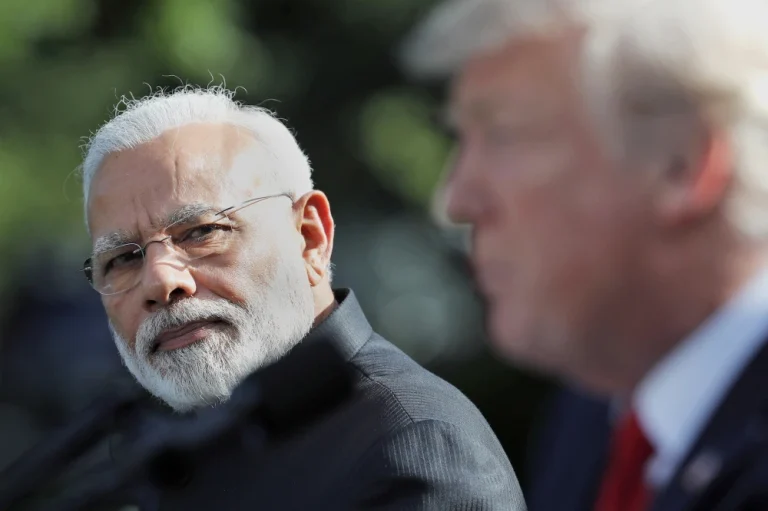U.S.-India Ties Strained as Trump Threatens Tariffs Over Russian Oil Imports
The once-warming alliance between the United States and India is facing a sharp downturn, as President Donald Trump threatens to significantly raise tariffs on Indian imports in retaliation for New Delhi’s continued purchase of Russian oil.
At the beginning of the year, India appeared poised to be a favorite in Trump’s second-term foreign policy. As a rising regional counterbalance to China, and with Prime Minister Narendra Modi enjoying a close personal rapport with Trump, the outlook for U.S.-India relations was bright.
But those hopes have dimmed. Relations have deteriorated amid a growing list of disagreements—chief among them, trade, technology, and energy policy. Trump has publicly criticized American companies like Apple for manufacturing in India, moved closer to Pakistan—India’s longstanding rival—and derided India’s economy as “dead.”
“He’s threatening to undo, or at least pause, two decades of progress in U.S.-India relations,” said Dhruva Jaishankar, executive director of the Washington-based Observer Research Foundation America.
On Monday, Trump sharply escalated tensions by announcing plans to “substantially” raise tariffs on Indian goods, citing India’s “massive” purchases of Russian crude oil. Indian goods already face one of the highest U.S. tariff rates in Asia at 25%. India is one of the top buyers of discounted Russian oil, along with China, a move Western countries have discouraged since Russia’s 2022 invasion of Ukraine.
India quickly pushed back. In a statement, the Ministry of External Affairs called the criticism “unjustified and unreasonable,” adding that India had purchased Russian oil with full knowledge and support from the U.S.
“India began sourcing from Russia because traditional suppliers redirected shipments to Europe after the war began,” the statement said. “At the time, the United States actively encouraged this to stabilize global energy markets.”
The White House did not immediately respond to requests for comment.
From Warm Embrace to Trade Tensions
The downturn marks a stark contrast to earlier this year, when Modi was one of the first foreign leaders to visit the White House following Trump’s return to office. Echoing Trump’s trademark slogan, Modi declared his intent to “make India great again.”
That honeymoon was short-lived. Since then, Trump has publicly criticized India’s growing role in American manufacturing. Last quarter, India accounted for 44% of U.S. smartphone imports—surpassing China—thanks largely to Apple’s decision to move iPhone production to India.
But Trump appeared unimpressed.
“I told Tim Cook, I don’t want you building in India,” Trump said in May, referring to the Apple CEO. “Build in America—even if it’s harder.”
A Shift Toward Pakistan?
The relationship took another hit in April following a deadly terrorist attack in Indian-controlled Kashmir that killed 26 people. India retaliated with airstrikes on Pakistan, reigniting tensions between the nuclear-armed neighbors.
Trump claimed credit for brokering a ceasefire—an assertion welcomed by Islamabad but flatly denied by New Delhi. India made it clear that no foreign government played a role in defusing the crisis, even after Trump and Modi spoke by phone.
“India has not endorsed Trump’s claim,” said Amitendu Palit, a former Indian finance ministry official and current research fellow at the National University of Singapore. “That hasn’t gone over well with Trump.”
Shortly after, Trump hosted Pakistan’s army chief in a highly unusual White House meeting. He also announced lower tariffs on Pakistani goods—19% compared to India’s 25%—and a new bilateral deal to explore Pakistan’s untapped oil reserves.
The Russia Factor
Another source of friction is India’s relationship with Moscow. For decades, New Delhi has pursued a non-aligned foreign policy, balancing strong ties with both Washington and Moscow. Russia remains one of India’s top suppliers of oil and defense equipment.
After Western nations sanctioned Russian oil exports in 2022, India seized the opportunity to import crude at a steep discount. At the time, U.S. officials even praised the move for stabilizing global oil prices.
“They bought Russian oil because we wanted someone to,” said Eric Garcetti, the U.S. ambassador to India under former President Joe Biden. “That was the design—to prevent global oil prices from spiking.”
But Trump’s tone has shifted dramatically. In a recent social media post, he mocked both countries, saying: “India and Russia can take their dead economies down together.”
“The U.S. is no longer just punishing Russia—it’s also turning up the heat on its allies,” said Palit. “India is starting to feel that pressure.”
India’s Strategic Calculations
Although Trump’s actions are unlikely to push India out of the U.S. orbit entirely, experts say they may prompt New Delhi to diversify its alliances.
India and China, despite deep-rooted tensions, recently resumed direct flights after a five-year freeze—an outcome of their foreign ministers’ meeting in Beijing last month.
“India may start looking more seriously at other partnerships, including with China,” Jaishankar noted.
Still, others believe the long-term trajectory of U.S.-India relations remains intact.
“India will continue to see the U.S. as a key strategic and technology partner,” said Chietigj Bajpaee, a South Asia expert at Chatham House. “But this moment is definitely a wake-up call.”

